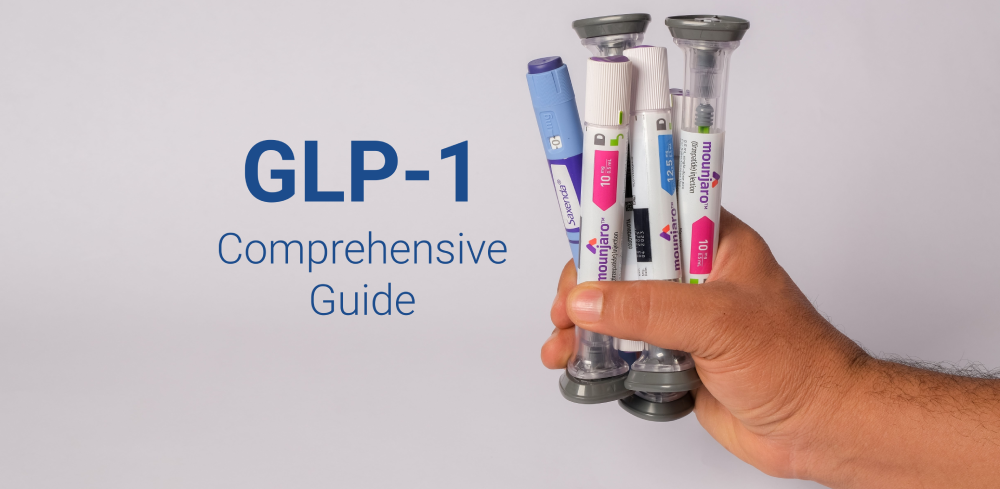
What does Semaglutide
do to the body?
Updated May 31, 2024


Kristi Perry, PA-C
Eli Luft, PA-C
Key Takeaways
- 1. Semaglutide affects the pancreas, GI tract, heart, brain, metabolism, and liver to promote weight loss.
- 2.It slows gastric motility, increasing feelings of fullness and reducing appetite.
- 3. It also enhances insulin production and sensitivity, improving blood sugar control.
- 4. Semaglutide alters brain signals related to hunger and food reward, helping change eating behaviors.
- 5.It promotes fat oxidation, encouraging the body to use stored fat for energy.
Introduction
Suppose you’ve seen the recent addition of semaglutide (brand name Wegovy) to the list of FDA-approved treatments for weight management. In that case, you may wonder what sets it apart from other medical weight loss interventions. More specifically, what does semaglutide do to the body?
Is it new?
Semaglutide is not a new drug. According to drugs.com, semaglutide has been used to treat type II diabetes since receiving FDA approval under the brand name Ozempic in 2017 as a longer-lasting alternative to the daily self-injection, liraglutide (Victoza and other brand names).[1]
After practices reported significant weight loss trends among users of semaglutide for diabetes, semaglutide was sent into FDA trials to be approved for weight loss therapy.
Semaglutide was sent into clinical trials in June 2018, and STEP 1 was completed in March 2021. Participants were monitored for 68 weeks (1.3 years) and given lifestyle interventions to adopt, encouraging 150 minutes per week of increased physical activity combined with a reduced calorie diet. At the conclusion of the STEP 1 trial, the average weight loss among the 1,961 participants averaged 14.9% of their initial body weight.[2]
For example, if a participant started at 260 pounds and lost 14.9% of their body weight, they would have lost 38.7 pounds. Our practice routinely sees people lose 20% of their starting body weight when they adopt our recommended lifestyle changes in conjunction with weekly semaglutide injections. [3]
What kind of medication is it?
Semaglutide belongs to a class of medications called “GLP-1.” GLP-1 is a hormone that our body naturally produces in response to the presence of food in the stomach. Once the body makes this hormone, it is circulated throughout and received by receptors in the pancreas, intestines, heart, brain, and more. However, the organs mentioned above play a role in weight loss, and this is where I will be primarily focusing on this article.[3]
The GLP-1 class of medications mimics this hormone naturally made in the body. In fact, semaglutide is 94% similar to the GLP-1 that our body produces. When given exogenously (via injection), it circulates in the blood just like our natural hormones do and affects the same organs in much the same way. Unlike some other weight loss interventions, such as phentermine, semaglutide does not behave as a central nervous stimulant to reduce appetite. Instead, it is used by multiple organs in unique ways to produce weight loss results.[3]
As I mentioned before, semaglutide has been used as a once-weekly injection to treat type II diabetes since 2017.
Before this, patients used a similar drug, liraglutide, to treat diabetes. Semaglutide helps reduce high blood sugar levels, the primary focus of treatment for diabetes. Any weight loss resulting from the medication is a bonus for patients.
What about its use in weight loss?
Semaglutide has been used since 2021 under the brand name, Wegovy, to treat patients with a BMI of 30 or more and patients with a BMI of 27 or more with co-existing weight-related medical problems, including high blood pressure, high cholesterol, obstructive sleep apnea, or heart/vascular disease.[4]
As I mentioned above, semaglutide is circulated throughout the body and takes roughly one week to be eliminated through the urine and feces.[5]
During its circulation, it interacts with several organs that work together to contribute to weight loss.
The Pancreas
When semaglutide interacts with the pancreas, it affects insulin production. Insulin is released in response to increased blood sugar, such as when food is ingested. The pancreas has very specialized cells called ‘beta cells’ that secrete insulin. Semaglutide increases the secretion of insulin from the beta cells. In addition to this, semaglutide also improves insulin sensitivity throughout the body.[3]
What is insulin sensitivity, and why does that matter? Well, insulin’s job is to remove sugar from our blood and put it into our cells so the body can use it for energy. When we are insulin resistant, the insulin cannot effectively remove the sugar from the blood and put it into our cells. So, when we lack the ability to use the available sugar for energy, the sugar remains in the blood, which leads to diabetes.
Increased insulin production and increased insulin sensitivity mean that we can more effectively move sugar out of the blood and into the cells, where it can be used for energy production and reduce our risk of developing diabetes.
The Gastrointestinal Tract
Semaglutide works in the GI tract in a few different ways. The most apparent way that semaglutide helps curb hunger is by slowing down gastric motility. In other words, food stays longer in the stomach, making us feel fuller longer. It doesn’t just slow the emptying of the stomach; it slows down gastric motility in general. It also increases intestinal mucous production and decreases acid production. These changes may be the primary cause of the gastrointestinal side effects that some patients may experience, including nausea, diarrhea, or constipation.[3]
The Heart
Though semaglutide is safe for most people with cardiovascular disease, there are receptors for it in the heart, specifically on portions of the heart that control your heart rate.
Some people may experience an increase in heart rate. If you have a history of troubles with heart racing or other medications that may raise your heart rate, it would be advisable to check with your doctor before starting semaglutide to ensure safety.[6]
The Brain
One of the most exciting and unique effects of semaglutide is its effect on the brain.
Our brain has a part that controls hunger and satisfaction called the hypothalamus. Semaglutide appears to work on the hypothalamus to increase feelings of fullness and alter the food/reward system and change taste preferences.[3]
These changes allow people to control food intake more easily than before starting the medication, which plays an essential role in changing behaviors surrounding food and weight loss. Likewise, changes in food preference tend to favor lower fat and healthier foods than before the medication. We often see changes in food preference in practice, and patients are always excited to notice these changes.
Our Metabolism
Semaglutide appears to impact metabolism beneficially by promoting fat oxidation, meaning it preferentially breaks down stored fat for energy.[3]
The body’s typical first choice for energy is carbohydrates because they are easy to break down and utilize. Semaglutide increases the use of stored fat for energy, helping promote weight loss.
The Liver
Finally, the liver has the ability to make sugar through a process called gluconeogenesis. This fancy word means “to generate new sugar.” When gluconeogenesis is discouraged, such as when taking semaglutide, there is less circulating blood sugar for the insulin to move into the cells.[3]
So, there you have it! Though the exact way semaglutide causes weight loss is unknown, the above changes appear to impact weight loss positively. These are the primary ways semaglutide affects the body and how these effects can encourage weight loss.

Lose Weight. Feel Great.
Rivas Medical Weight Loss is here to guide you
with expert care and top quality medication.
Book Appointment
Bibliography
-
https://www.drugs.com/history/ozempic.html. Published 2022. Accessed July 20, 2022.
-
Phillips A, Clements J. Clinical review of subcutaneous semaglutide for obesity. https://doi.org/10.1111/jcpt.13574. Published 2022. Accessed July 20, 2022.
-
https://www.acc.org/latest-in-cardiology/clinical-trials/2021/02/18/19/23/step-1. Published 2022. Accessed July 20, 2022.
-
Weight-Loss Prescription Medication | Wegovy™ (semaglutide) Injection 2.4 mg. Wegovy.com. https://www.wegovy.com/. Published 2022. Accessed July 20, 2022.





